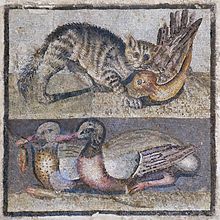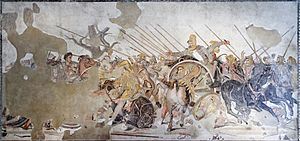Opus vermiculatum


The opus vermiculatum (Latin opus "work" or "technique"; synonym: Pavimentum vermiculatum) is a mosaic technique in which outlines are drawn around shapes, for which tesserae are used. The tesserae were often square, but could have other shapes. The main purpose of the Opus vermiculatum technique is "to paint in stone".
This can be one or more rows that contrast with the background in Opus tessellatum .
The name Opus vermiculatum (plural: opera vermiculata ) means worm-shaped (vermis = Latin for worm), which refers to the worm-shaped, wavy course of the rows of tesserae, which are typical for this technique.
The Opus vermiculatum mosaic technique is said to be one of the most demanding and sophisticated mosaic techniques of the Roman mosaics.
Opus vermiculatum is mainly used for figure compositions and made of very small stones, up to a few millimeters in size (compared to Opus tessellatum ), in order to allow fine color gradations and to be able to follow the contours and outline of the figures precisely.
The Opus vermiculatum technique is mainly used for the central figure compositions or for the central mosaic, which is then surrounded by geometric or floral motifs that are executed in the coarser Opus tessellatum technique, for which much larger mosaic stones are used. Occasionally only essential details, e.g. B. Faces of the figures, executed in Opus vermiculatum, while the mosaic is otherwise executed in Opus tessellatum.
Usually the opus vermiculatum should emphasize the main motif and details in the foreground. A smooth and flowing halo effect was used for this.
history

The Opus vermiculatum technique had its origin in Greece and was later developed than the other mosaic techniques. The first example is the Sophilos mosaic in Thmuis , dating from around 200 BC. Is dated.
Opus vermiculatum spread throughout the Hellenistic world, including Egypt . It was found in Egypt from the late 3rd to the 1st century BC. Used for the grave decoration. This mosaic technique lasted a long time in Syria.
The Nile mosaic shows a very sophisticated use of colors and a very sophisticated technique. This could suggest that this technique is based on paintings.
The earliest known example of an Opus vermiculatum mosaic is in the Greco-Roman Museum in Alexandria , this mosaic portrait of a woman represents the embodiment of the city of Alexandria and was made around 200 BC. Chr.
End of the 1st century BC The Romans had adopted this technique along with the other mosaic techniques, possibly by hiring Greek mosaic artists for this work. In Pompeii numerous great mosaics using the Opus vermiculatum technique have been found.
The use of the opus vermiculatum declined after the 1st century AD, but continued to be used as the main stylistic device for finer Roman mosaics until the 4th century. Then the mosaics became increasingly impressionistic, taking advantage of the color reflections of the glass tesserae, which better matched the opus tessellatum. With the increasing spread of mosaic decorations for walls and vaults during the early Christian period, the opus vermiculatum technique was completely abandoned - in favor of an increasingly more impressionistic opus tessellatum technique, which was more impressive at greater distances.
See also
literature
- Marion Elizabeth Blake: The pavements of the Roman buildings of the Republic and early Empire. American Academy, Rome 1930
- M. Donderer: The ancient Paviment types and their names. In: Yearbook of the German Archaeological Institute 102 (1987). Pp. 365-377
- Walter Hatto Gross : Opus vermiculatum. In: The Little Pauly (KlP). Volume 4, Stuttgart 1972, Sp. 575 f.
- Christoph Höcker : Metzler Lexicon of Ancient Architecture. 2nd Edition. Metzler, Stuttgart 2008, ISBN 978-3-476-02294-3 . P. 193
Web links
Individual evidence
- ↑ PGP Meyboom: The Nile Mosaic of Palestrina: Early Evidence of Egyptian religion in Italy. Brill Academic Publishers, 1994, ISBN 90-04-10137-3 , p. 379
- ↑ Fig
